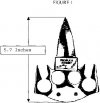OK, I've done a little research, which hasn't really helped at all.
The Colorado Criminal code, Section 18-12-101, states that "(f) 'Knife' means any dagger, dirk, knife, or stiletto with a blade over three and one-half inches in length, or any other dangerous instrument capable of inflicting cutting, stabbing, or tearing wounds, but does not include a hunting or fishing knife carried for sports use. The issue that a knife is a hunting or fishing knife must be raised as an affirmative defense." Knife is so defined because the Code used to criminalize the carrying of a "knife," without any further definition, so apprently in the 70s the legislature decided to define "knife" so that people with SAKs wouldn't get tossed in jail.
OK, fine, but how do you measure blade length? Strangely there are no reported CO cases on this. There are 2 cases that are interesting, but not particularly helpful:
(1) People v. Pickett, 194 Colo. 178, 571 P.2d 1078 (Colo. 1977)
"Defendant further asserts that the knife as it related to Count III (carrying a concealed weapon), had a blade less than 31/2 inches long, as defined by section 18-12-101(1)(f), C.R.S.1973. The evidence was undisputed that the blade of the knife measured 31/2 inches in length from its tip to the point where it was hinged to the knife handle, and that the overall length of the blade was more than 31/2 inches. In our view, it was not therefore inappropriate for the trial court to rule as a matter of law that the knife in question was the type defined by the statute."
I have NO idea what the court is talking about here - the blade was 3.5" long when opened, but there was some blade still in the handle, so if you took the knife apart the "blade" would be longer? Without a pic or more information this is no help, & the court provides neither.
(2) A.P.E. v. People, 2001, 20 P.3d 1179.
Carrying concealed knife with blade less than three and one-half inches was not by itself violation of concealed weapons statute; rather, prosecution was required to show intent to use knife as weapon. (This is the challenge someone referred - see definition of knife above)
Here the court does a favor & provides a pic, but the actual blade length is unclear.
NOTE that, regardless of whatever state statute declares, local county or municipal governments can enact more stringent regulations. So if Coclrado ok's 3.5" but Denver limits it to 2.5", if you are busted in Denver with 3" you will face prosecution for violating a city or county ordinance.
Now to make myself really popular - when I used to prosecute these cases in my local courtroom, I would argue (and it only came up on a theoretical basis, we weren't nailing guys with SAKs) that blade length is determined by how far you can stick the blade into someone before you get the handle messy. I.e. tip to guard or beginning of handle. That's the rule of thumb I'd watch out for, it's common-sense, which carries a lot of weight with judges (sometimes). That said, the only people with knives that I ever prosecuted were rocket-scientists who decided to antagonize the police while carrying a knife, or known (and I mean KNOWN - they would show me their new scars with pride each time we met in court) gangbangers. Plus one kid who brought a 7" WWI trench knife to school (you know, the brass-knuckle dealy).
Basically, if you don't bug the coppers, they will let the extra 1/16" of blade that I think you've got there, slide on by. If you do bug the coppers, I don't think the results of this learned poll will help you much.



